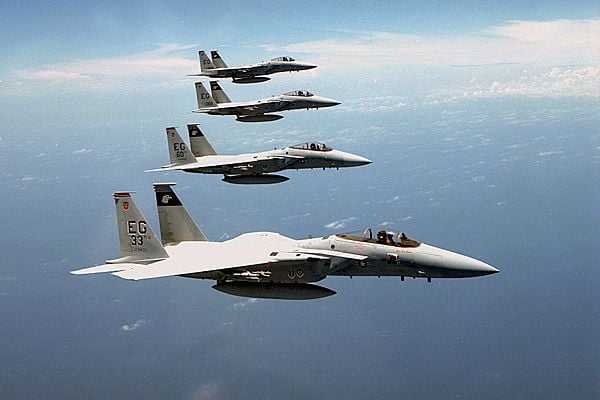Military
Defense and Warfare Stocks Starting to Gain from Syria Military Action
Published:
Last Updated:
It was barely over a week ago that we couldn’t help but notice how the aerospace and defense stocks were getting hit hard to lower share prices despite the notion that military strikes in Syria seemed almost certain to us. Maybe it was just market volatility and too close to the time that spending cuts in defense were coming across the board. It seems that the politicians are now nearly certain to approve the launch air strikes against Syrian ground assets, and it turns out that the military industrial complex’s stock prices are finally getting some respect from Wall Street again. Source: Courtesy Boeing Co.
Source: Courtesy Boeing Co.
As a reminder, when nations go to war it is this military industrial complex that generally wins. Almost all the products of warfare have a high cost. None of the weapons magically reproduce or make more of themselves. And many modern weapons are very expensive one-time weapons. Warfare is simply a very costly business.
If our assumptions are correct, Syria and Mr. Assad are more than just likely to find themselves on the receiving end of hundreds or thousands of advanced munitions and weapons and monitoring devices.
Wall Street has finally decided that warfare stocks might line the pockets of investors. The real risk here is that the strikes will be very short-lived and not carry on for very long. After all, it seems that no one in Washington D.C. is going to favor boots on the ground in Syria at this point. For that matter, no regime change seems likely. Another risk is that some are deemed very close to being fully valued.
Alliant Techsystems (NYSE: ATK) is the largest maker of bullets, so it may not seem an obvious winner outside of its advanced munitions. Its stock was up 0.8% at $97.32 on Wednesday afternoon, but this is till lower than the $97.85 a week or so ago when defense stocks were getting gutted. This stock was a bullet hoarding and doomsday prepper winner and its 52-week range is $48.00 to $103.77. If we are not going to put boots on the ground in Syria, then waves and waves of new bullet orders are not likely coming. The consensus price target for Alliant is $101.82, so it may be closer to an implied full-value.
Boeing Co. (NYSE: BA) is up 1.9% at $107.04 in late-Wednesday trading. Our take is that Boeing now is more dependent on its commercial plane orders. It has rallied like an industrial stock since last Tuesday when its shares were down 2.1% at $103.32. Boeing’s 52-week trading range is $69.03 to $109.49, yet the consensus price target is $122.59.
General Dynamics Corp. (NYSE: GD) is up 0.8% at $85.00, and this is up versus the 1.4% drop down to $83.08 when we pointed out this a week ago. General Dynamics has a 52-week trading range of $61.70 to $87.85 and its consensus analyst target is still all the way up at $95.80.
Lockheed Martin Corp. (NYSE: LMT) is up 0.8% at $124.61 versus a price of $123.25 last week. It has a 52-week trading range of $85.88 to $126.73 and its consensus analyst target is $127.13. The highest target is all the way up at $149.00, but the value today is close to both the consensus and to the highest price historically.
L-3 Communications Holdings Inc. (NYSE: LLL) is also now back above the price a week ago, up 0.9% at $91.40 versus $90.80 at the time. Its 52-week range is $68.72 to $94.32 and the consensus price target is still $94.64. L-3 may be more for communications on the surface, but it is involved in many aspects that advanced systems need.
Raytheon Co. (NYSE: RTN) is up another 0.8% at $76.82, also slightly higher than the $75.33 when this was addressed last week. Its 52-week trading range is $52.24 to $77.93 and its consensus analyst target is $74.59. Unfortunately, that puts Raytheon above the consensus price target even if the highest price target is above $90.00 here.
We have mentioned before that targeted military action against Syria could bring almost no significant boost worth noting to the defense sector. That may even be likely, unless there is a spillover or unless Syria decides to start targeting Israel. Here are some statistics for Syria according to the CIA World Factbook:
A financial advisor can help you understand the advantages and disadvantages of investment properties. Finding a qualified financial advisor doesn’t have to be hard. SmartAsset’s free tool matches you with up to three financial advisors who serve your area, and you can interview your advisor matches at no cost to decide which one is right for you. If you’re ready to find an advisor who can help you achieve your financial goals, get started now.
Investing in real estate can diversify your portfolio. But expanding your horizons may add additional costs. If you’re an investor looking to minimize expenses, consider checking out online brokerages. They often offer low investment fees, helping you maximize your profit.
Thank you for reading! Have some feedback for us?
Contact the 24/7 Wall St. editorial team.